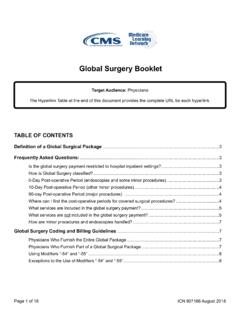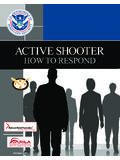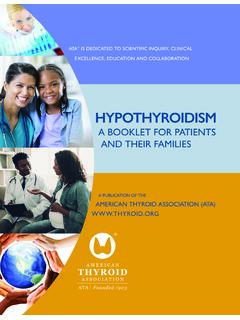Transcription of Ready Set Test Booklet
1 Get the right TESTINGIS TESTINGIS TESTINGIS !TEST!TEST! Ready ? Ready ? Ready ? Division of Laboratory SystemsCenter for Surveillance, Epidemiology, and Laboratory Services CS255581-AIntroduction iiiIntroductionBackgroundHealth care providers use test results to diagnose disease, determine prognosis, and monitor a patient s treatment or health status. Current practice shows an increased trend for medical decisions based on simple tests performed at the point of care. Many of these tests are called waived tests and can be performed without routine regulatory oversight under a Certificate of Waiver from the Centers for Medicare & Medicaid Services (CMS).
2 Waived tests include test systems cleared by the Food and Drug Administration (FDA) for home use and those tests approved for waiver under the Clinical Laboratory Improvement Amendments of 1988 (CLIA) criteria. The FDA list of waived tests is continuously being revised as new tests are waived. The most current information on FDA cleared waived tests can be found at the following website: PurPoseCLIA requires that waived tests must be simple and have a low risk for an incorrect result. However, this does not mean waived tests are completely error-proof. To decrease the likelihood of incorrect results, waived testing needs to be performed correctly, by trained personnel and in an environment where good testing practices are followed.
3 Although not routinely done, the Centers for Medicare & Medicaid Services (CMS) will inspect waived testing sites under certain circumstances such as: if a complaint is made, to determine if the testing site is performing tests not permitted with a certificate of waiver, if there is risk of harm to a patient due to inaccurate testing, and to collect information about waived Booklet describes recommended practices for physicians, nurses, medical assistants, pharmacists, and others who perform patient testing under a CLIA Certificate of Waiver. The CLIA requirements for testing under a Certificate of Waiver can be found here: some of the recommendations in this Booklet exceed CLIA requirements for waived testing, following these good testing practices will likely lead to reliable, high quality test results and will enhance patient safety.
4 Contents vContentsIntroduction ..iiiBackground ..iiiPurpose ..iiiREADY? ..1 Overview ..1 Prepare for Testing ..1 The Test Instructions ..1 Know How to Do the Test the Right Way ..2 Off-Label Use of Waived tests ..2 Quality Control Testing .. 2 SET? .. 4 Overview ..4 Test Ordering ..4 Patient Preparation ..4 Sample Collection ..4 Collection Devices ..5 Sample Labeling ..5 Safety Issues ..5 Biohazardous Waste ..6 Disinfecting Work Surfaces ..6 TEST! ..7 Overview ..7 Performing the Test ..7 Reading the Results ..7 Resolving Problems ..7 Recording Results ..8 Issuing Test Reports ..8 Confirmatory or Supplemental Testing ..9 Public Health Reporting.
5 9 Record Keeping ..9 Proficiency Testing ..10 Quality Assessment ..10 Tips, Reminders, and Resources ..12 Ready ? ..12 Set? ..12 Tes t! ..12 Reminders ..13 Resources ..13 Safety Links ..13 Appendix A ..14 Temperature Log Instructions ..14 Appendix B ..19 Common Components of a Manufacturer s Instructions ..19 Appendix C ..20 Quality Control Log Instructions ..20 Instructions for Logging or Recording Results ..26 Appendix D ..38 Hand Hygiene Job Aid ..38 Blood/Body Fluid Exposure ..40 Glove Removal Job Aid ..41 Appendix E ..43 Common Disinfectants and Antiseptics ..43 Appendix F ..44 Terms and Abbreviations ..44 Ready ? 1 Ready ?overviewCertain steps need to be taken even before a test is begun to be sure results are accurate.
6 Most importantly, follow the manufacturer s instructions throughout the testing process. Problems found in testing sites that perform waived tests are most often the result of not following this critical step. Pre Pare for Tes TingTesting should be performed in an area with adequate space to safely conduct testing while maintaining patient privacy. Testing and storage areas should be monitored to be sure they meet specific environmental requirements described in the manufacturer s instructions. Equipment used for testing should be maintained and calibration checks should be performed as directed in the manufacturer s instructions. Some important points to consider are:99 Clean work surfaces before and after testing in a well lit and record temperatures of the testing and reagent storage areas.
7 See Appendix A for examples of daily temperature logs. 99 Check inventory regularly to ensure you will have enough reagents and supplies on hand for testing. 99 Check and record expiration dates of reagents/kits, and discard any reagents or tests that have expired. 99 Check that all kit reagents came from the same kit lot. Do not mix reagents for damage, discoloration, or contamination, and discard if reagents according to manufacturer s instructions. 99 Allow time for refrigerated reagents/samples to come to room temperature prior to equipment and electrical connections to be sure they are working. 99 Perform equipment calibration checks, as needed, following the manufacturer s Tes T ins TrucTions Testing sites that perform testing under a CLIA Certificate of Waiver must follow the current manufacturer s test instructions.
8 See Appendix B for an explanation of the common components found in a manufacturer s instructions. Keep in mind that manufacturer s instructions may be updated or changed and instructions from different manufacturers for the same type of testing, such as glucose, may not be the same. The following steps should be taken to be sure the current test instructions are being followed: 99 Keep a copy of the manufacturer s instructions on hand for easy the manufacturer s instructions with each new lot and shipment of test kits to make sure there are no changes from the test kits being the old manufacturer s instructions and replace with the new copy if there are all changes in the manufacturer s instructions to other testing personnel and to the person who directs or supervises manufacturers provide quick reference instructions that can be posted in the testing area.
9 If manufacturer s instructions are updated, the quick reference instructions may need to be updated as well. If your testing site has a procedure manual, the site specific procedure will need to be Ready ?know how To do The Tes T The righT way99 Read and understand the manufacturer s instructions and/or site specific the manufacturer if there is any information that is not safety precautions including Occupational Safety and Health Administration (OSHA) guidelines: 99 Practice all tests , while an experienced person watches, before testing patient samples and reporting patient training on all tests in staff personnel files. off-LaBeL use of waived Tes TsBased on the testing site s need and the unique population it serves, there may be instances when the site chooses to modify an FDA-cleared or approved test system.
10 Modification means using a test system in a way other than that described in the intended use, precautions, limitations, or other sections of the manufacturer s instructions (See Appendix B for an explanation of the common components found in a manufacturer s instructions). The modified use of a test system is considered off-label use because it is not supported by the manufacturer s clinical data and it is not part of the FDA-cleared or approved instructions. Off-label use , or modified use of a test system, defaults the test to the high-complexity testing category under CLIA regulations, and will require sites using the modified test system to meet all applicable CLIA requirements for high-complexity testing.


















